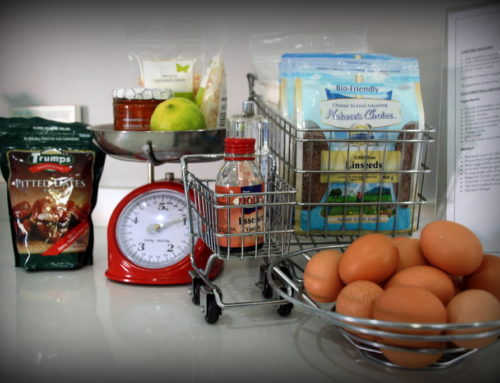‘You don’t have to like it, you only have to eat it!’
In my previous book ‘Raising Happy, Healthy Children’ I covered diet extensively with the help of a clinical nutritionist, Sally Ann Creed, with whom the book was co-written. However, I think it is important to reiterate that what we eat affects the way we behave. The two go hand in hand. You cannot discipline a child who is being fed incorrectly, and conversely, you cannot enforce healthy eating if you have no discipline in place.
- Feeding a child sugar and expecting them to sit still is like expecting an intoxicated person to walk a straight line.
- We would all agree that alcohol affects our brain, but some people struggle to accept that food, also, can affect our brain, responses and general well being.
- If malnutrition makes you ill, why would the opposite not be true? Some foods can also affect behaviour and hormone functions in teenage years.
- Mood swings, aggression, loss of concentration, passivity, irregular or severely painful menstrual cycle, bad skin, memory loss and other problems can all be connected to a food in- tolerance or deficiency of some sort. It would be wise to check this out with your doctor or a nutritionist that you trust.
I read a bumper sticker that said, ‘If you ignore your health, it will go away.’ This is so true. Sometimes people say to me, ‘Well, I do not eat vegetables and look at me, I’m fine!’ To which I respond, that sounds like saying, “I do not have to service my car. It is running just fine.”But when it has a costly breakdown that could have been prevented with a simple timely service, you regret it.
We need to train our children in healthy eating habits so that as adults they will not be picky eaters but rather enjoy the full spectrum of fruits, vegetables, proteins and other foods that are freely available today.
If you do not teach this, who will?
To sum up, studies show that a healthy diet consists of three meals per day and two snacks. Each meal should contain a healthy form of protein. Here is a suggestion of a healthy routine for the whole family (the portion size is adjusted accordingly):
Breakfast:
- Cooked oats, sorghum, quinoa or millet porridge (not the instant kind). For variations with the porridge add cinnamon, cashews, almonds, grated apple, banana, local honey, organic coconut oil or combinations of these. Adding raw cacao can also quickly turn it into a special chocolate breakfast.
- Keep in mind that grains are best absorbed by the body when they have been soaked, preferably for anywhere from 1-12 hours. This ‘increases digestibility, and eliminates phytic acid’ according to Integrative Nutrition.
- You can make the porridge by pouring boiling water over it and leaving it overnight to soak, and just topping up with boiling water in the morning to heat it up. Or for a faster option, you could just pour the boiling water over your porridge in the morning, cover it, and it’ll be ready in three minutes (that’s right, you don’t need the microwave or stove).
- For an incredibly delicious special treat, add egg yolks into hot porridge (first stir some hot porridge into the beaten egg yolks before adding to the hot porridge). Then beat egg whites till stiff and fold in gently. Serve with cinnamon and xylitol.
- Another breakfast option would be any variety of free-range eggs with whole grain bread if you wish (don’t be fooled by multi-grain; whole grain ingredients should be the first on the ingredient list if you have bread) and/or tomatoes, mushrooms, sautéed onions, peppers, etc.
Mid-morning:
- Variety of fruit, nuts and seeds (not peanuts), plain full cream yoghurt (flavoured and/or sweetened yoghurts can do more harm than good, even the probiotics in them could become ineffective because of the sugar content); or
- Cracker breads with any nut butter (almond, cashew) or cream cheese;
- Green smoothies. Blend at least three organic kale leaves (or spinach, or any type of leafy green) with filtered water (this helps to blend it to a smooth consistency, rather than having bits of greens to chew). You get more benefits from leafy greens when they are blended. You could also add chia seeds and/or raw oats at this point to be ground up. The nyou can add banana (frozen makes for a more frothy smoothie) and any combination of these and other ingredients: nut butter, cacao, berries (again, can be frozen), nuts, coconut oil, carrot, raw beetroot (don’t judge it until you try it – it’s a pleasant surprise), maca, pear, etc. Try to have more vegetable than fruit where possible, just adding the fruit for some sweetness. If your children prefer a sweeter taste, you could add a touch of local honey (which can help with seasonal allergies) or xylitol. You can also blend in ice if you like a more frothy smoothie.
Lunch:
- Half of the plate should be filled with a variety of vegetables (raw/ steamed/roasted).
- A quarter of the plate with a healthy carbohydrate (e.g. quinoa, sweet potato, basmati or brown rice, healthy pasta, whole grain bread, etc). It’s better if you can include complex carbohydrates, as oppose to simple.
- A quarter of the plate with protein (lentils, fish, red meat, chicken, eggs, beans, etc).
- At least 10-20% of your food needs to consist of healthy fats (coconut oil, olive oil, oily fish, avocado, nuts, etc).
Mid-afternoon:
- Crudités with a protein (hummus, white cheese, cream cheese, cottage cheese, meat, fish, lentils, red kidney beans). You could try making this more appealing by creating a pattern or picture out of the food.
Supper:
- Same make-up as lunch, but try to make something different so that you’re not serving the same thing on one day. You could, however, keep some dinner as leftovers for lunch the next day. It’s always more convenient for families if you can cook once, eat twice.
- This would typically happen around 8 am, 10 am, 12 pm, 4 pm and 6 pm, depending on your lifestyle.
- Water should be encouraged as the main source of liquid through-out the day, and vegetables should be your main source of nutrients.
- Try juicing carrots mixed with a little apple, cucumber or celery, or be creative with a variety of veggies, as a wonderful way of increasing the daily vegetable intake.
- To make it more exciting, you could give different names to the various colour veggie juices.
- Remember that watered-down fruit juice is still not water.
- This can be given occasionally or as a transition to switching to water alone, but a house rule could be to first have a glass of water before the fruit juice. Your proportion of vegetables to your fruit per day should be at least double the amount of vegetables to fruit.
- Himalayan salt is also an excellent source of minerals for the whole family and should be eaten daily.
- Your body struggles to digest processed foods. It can break down nutrients in raw foods and knows how and where to distribute them. If you are craving sweets, try increasing your oil and protein in-take and see how much energy you have!
Try these for example:
Oat and coconut balls 1 cup oats (250g) 125 g almonds
Grind together till texture of % our.
Add:
10 ml of Xylitol
1 teaspoon raw honey
125 g desiccated coconut
A delicious optional extra – half a teaspoon of cacao (raw chocolate)
Mix in enough softened coconut oil to bind together. Roll into small balls then roll the balls in coconut. (optional extra: place a blueberry in centre of ball) Place in fridge for 5 minutes.
Ready to eat and enjoy!
This is delicious for an in between ‘pick-me-upper’ snack on the go, and your kids could have them as a special treat (little do The know how healthy it is).
See my book ‘Raising Happy, Healthy Children’ for more recipes. Including more sweet vegetables in your diet such as sweet potato, carrots, etc can also reduce sugar cravings. Even slicing butternut, sweet potatoes or beetroot extremely thinly and then frying them in coconut oil can be a delicious snack or meal accompaniment. This can also be a great lunch box idea for school.
- Read your labels and watch out for and avoid ingredients like Mono- sodium Glutamate (flavour enhancer), preservatives, nitrates, incorrect/ unhealthy oils and excessive sugars and salt, to name but a few.
- Drinking water is vital for your body, as opposed to sugary carbonated drinks and excessive fruit juices.
- Xylitol and stevia are the healthy alternatives to sugar.
- Read the labels making sure that when it says sugar free, it is not aspartame, saccharine or non-nutritive sweeteners replacing the sugar.
- As a general rule, try to buy things with as few ingredients as possible.
- Reach for plain full-fat yoghurts and flavour them with fresh fruits.
- You could even try heating mixed berries in a saucepan until they break down and become sauce-like as a great addition.
- Avoid items that are fat-free as your body is in need of health
- y oils – such as coconut oil (the oil of choice when frying or roasting), and extra virgin cold pressed olive oil (for salads or any raw vegetables)– for protecting organs, nerves and so many other crucial functions.
- Often when something is fat-free or low fat, there are added sugars, or they have had to go through additional unhealthy processing to get to that point.
Where does discipline come in?
- I never start with an eating problem with children. I believe that parents need to be in charge in all areas, as they have more wisdom and the bigger picture.
- Therefore this authority needs to be established before sitting at the table.
- Remember that you cannot force your child to swallow, urinate or fall asleep.
- You can, however, expect them to try one bite, and you can expect them to stay in their beds.
- Around two years, most children go through a stage where they really do not eat a lot. This stage will pass, but be careful not to fall into the trap of, ‘Well, at least he’s eating yoghurt, chocolates and chips!’
Where possible, grow your own veggies
- Children can even eat the cherry tomatoes and green beans straight out of the garden with a quick rinse from the garden hose! Encourage them to help with the preparation of meals (age-appropriately). Children are more likely to eat healthy meals when they have been part of the cooking process.
- This can even start by getting them to help with selecting the vegetables at the grocery store, or better yet, picking them in the garden.
- For ‘bad’ eaters, take away all snacks in between meals.
- Give only water. Then when mealtime comes, offer the favourite meat, for instance, but on the same plate have a vegetable that he does not like. Expect him to take only one bite of the vegetable before he has his meat. Never fight over food. Meal times need to be friendly and chatty. He has one choice – try one bite, or no food.
- How will anyone ever know whether they like something if they have never tasted it? How will they develop a taste for it, if they are never expected to try it repeatedly?
Here is a great phrase to use for these occasions:
‘You don’t have to like it, you only have to eat it.’
- If they still refuse, announce that the timer will be set and when the bell rings, the plate will be taken away.
- Then take the meal away calmly, but expect them to stay at the table until everybody is finished.
- Make sure it is friendly and chatty.
- Be sure you don’t fall for the ‘I’m hungry’ tune in the middle of the night.
- Reply simply with empathy by saying ‘I’m so sorry you’re hungry! I’m sure you’ll try harder tomorrow night.’ Offer only water.
- There have never been cases reported of children dying of hunger when they have been offered food.
If your child has been a picky eater since transitioning from pureed foods to bitty foods, it could well be a sensory problem.
- Children with sensory issues will typically gag when trying a new food, or refuse to even touch it.
- Generally cherry tomatoes are a huge turn-off or yoghurt with bits of fruit.
- But this is not the only way to diagnose sensory issues.
- These problems have to be dealt with through Occupational therapists who specialize in Sensory Integration.
- This is not a discipline first approach.
- If they gag when eating, then just require a lick between mouthfuls.
- If their response is just, ‘I don’t like it’, then require one bite. With exposure, the brain could eventually change its negative response and start liking it.
- However, if your child has not had these problems and has become a picky eater, it could be discipline-related.
- Firm boundaries need to be put into place in all other areas before food issues are addressed.
- Once you are the parent in other areas (starting with discipline in the day first), you are in charge when it comes to the choice of food.
- The boundaries then become clearly defined.
- The choices are made clear; this is a lunch/supper/snack. ‘You don’t have to eat it. But there is nothing else until the next meal.’
- It is not advisable to have toys at the table or have the TV on.
- Your body has to combine forces for the digestive system to work efficiently.
- Your eyes, your nose, your mouth, your gastric juices all contribute to healthy digestion. When all of these are pre-occupied, this does not happen effectively.
- Never place too much focus on the food, force feed or show your anxiety.
- Your child will sense this and hold you hostage.
- Encourage a child to stop eating when they have had enough; The do not have to finish everything on their plate as this can lead to unhealthy eating habits later.
- If you have a slow eater, ignore this while you relax and chat and eat your meal.
- Then, remind him that the mealtime is almost over.
- Set an alarm for say, another five minutes and remind him calmly that when the bell rings, the plates will be taken away.
- You will probably have to remove his plate once only and he will get the message!
Recently I was with a mommy when she gave her son some blueberries (that he did not want to taste) and biltong (jerky) that he loved, for a snack. He was told to try the blueberries first. He sat for a long time talking to us but avoiding the eating. We finally decided to set the timer to ring after every minute. At the ring, we would be eating a piece of his biltong until he decided to taste a blueberry. He saw his biltong diminishing, but thought that his mom would replenish the bowl. Finally all the biltong was finished and his blueberries were taken away. He was horrified. However, the next time the timer was set, he quickly tried the food his mom had put down for him.
Mealtimes should be a fun, sociable time and valuable for interaction and quality time. Relax, chat and show by example that healthy eating creates happy, healthy individuals.
Food intolerances
If your child constantly suffers from either a runny nose, coughing, grommets in the ears, tonsillitis, sinusitis, eczema, asthma etc or shows signs of aggression, fuzzy brain, inattentiveness, clumsiness, tiredness, moodiness, diarrhoea, constipation, night terrors or bed wetting, it could be a dairy and/or wheat intolerance or allergy.
If you take out all wheat, milk, yoghurt and cheeses for six weeks and notice a difference, this could be the case. Try then to avoid any dairy or wheatfor about six months and then reintroduce slowly.
This is not necessarily a life sentence; often children’s bodies learn to tolerate it again after it has been removed from their diet for a while.
- Rice, almond, oat or goat’s milk is an alternative to dairy.
- Even liquidized banana with water can be used with porridges.
- Avoid soy milk where possible, as it is a very processed product.
- The market is filled with wheat or gluten-free flour alternatives.
- Focus on using whole grains like oats, corn or rye instead.
- Excessive sugar can also be affecting your child’s behaviour and break down his immune system. Look especially for the hidden sugars. Read your labels!
- If your child has a tendency towards biting, bullying, restlessness, bouncing off the walls, night terrors, lack of concentration or mood swings, try removing ALL forms of sugar from the diet (read the labels, you’d be surprised).
- Do not replace with anything containing aspartame or other artificial or non-nutritive sweeteners (especially watch out for some yoghurts or anything marked ‘sugar free’).
- Stevia or Xylitol are good alternatives, or occasionally RAW honey. Normal cheap honey is often watered down with sugar water and has gone through a heat process that destroys its good qualities.
- Pure fruit juice is also high in fructose, which, if a child is sensitive, can also affect them.This needs to be limited and watered down. The best alternative is to encourage children to drink water.
- Rooibos tea is very healthy and high in anti-oxidants, but without sugar and/or milk. You can make a rule that if they want to drink watered-down juice, they first have to have the equivalent size glass of water.
As this is not a book focused on health, I have not gone into too much detail. This is just an overview. For more in-depth information on health issues, go to sallyanncreed.co.za





